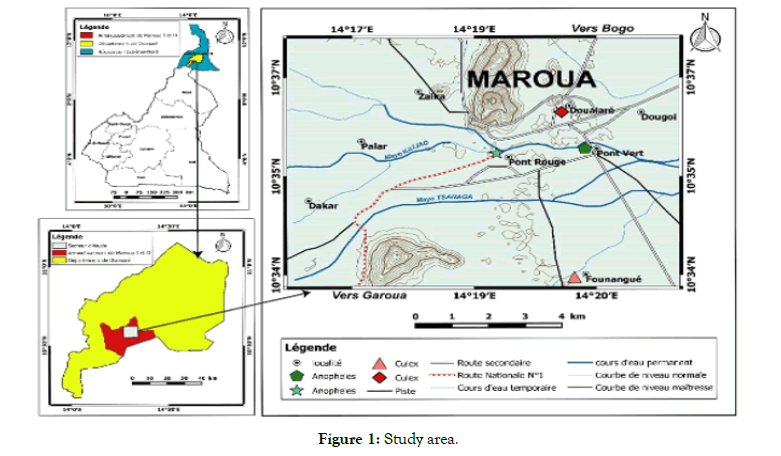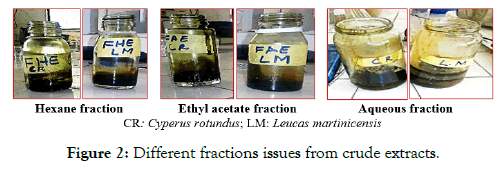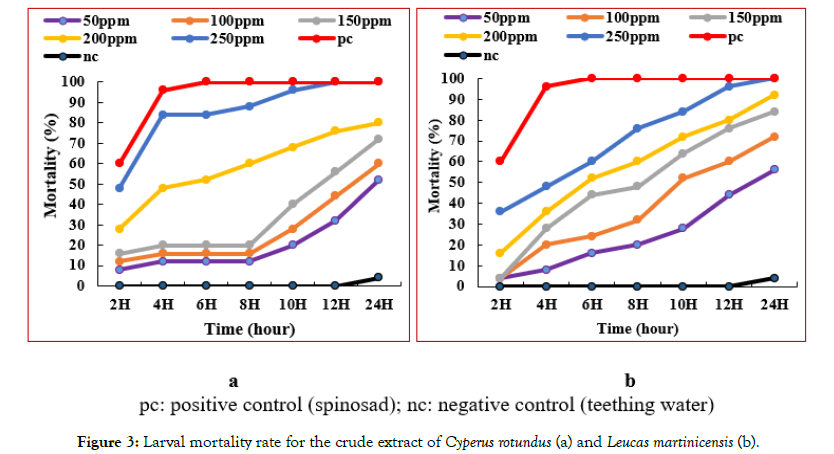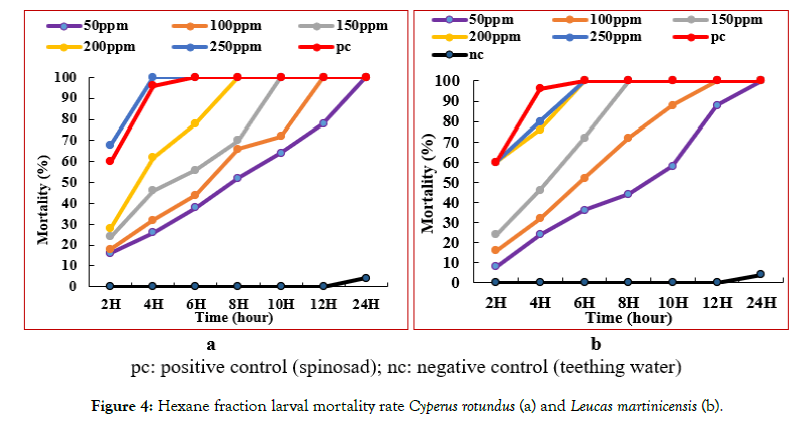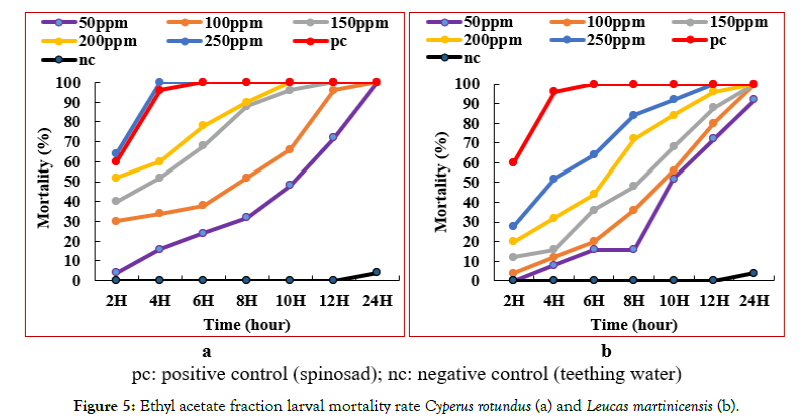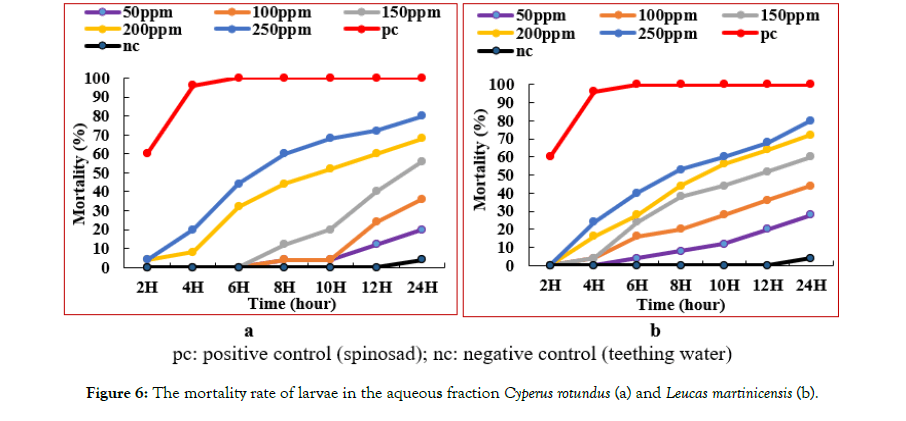Indexed In
- Open J Gate
- Academic Keys
- ResearchBible
- China National Knowledge Infrastructure (CNKI)
- Centre for Agriculture and Biosciences International (CABI)
- RefSeek
- Hamdard University
- EBSCO A-Z
- OCLC- WorldCat
- CABI full text
- Publons
- Geneva Foundation for Medical Education and Research
- Google Scholar
Useful Links
Share This Page
Journal Flyer

Open Access Journals
- Agri and Aquaculture
- Biochemistry
- Bioinformatics & Systems Biology
- Business & Management
- Chemistry
- Clinical Sciences
- Engineering
- Food & Nutrition
- General Science
- Genetics & Molecular Biology
- Immunology & Microbiology
- Medical Sciences
- Neuroscience & Psychology
- Nursing & Health Care
- Pharmaceutical Sciences
Research Article - (2021) Volume 9, Issue 1
Fractionation of methanolic extracts from two herbaceous plants and evaluation of their larvicidal activity on Anopheles arabiensis.
Bouba Théophile1*, Saotoing Pierre2 and Ndjonka Dieudonné32Department of Life and Earth Sciences, Higher Teacher’s Training College of Maroua, Cameroon
3Department of Biological Sciences, University of Ngaoundere, Cameroon
Received: 20-Oct-2020 Published: 28-Jan-2021, DOI: 10.35248/2329-891X.21.9.263
Abstract
With the objective of controlling malaria by reducing the populations of Plasmodium spp, vectors, fractions obtained from crude extracts of dry plants of Cyperus rotundus and Leucas martinicensis were analyzed and their larvicidal activity on Anopheles arabiensis determined. Biological tests revealed that the hexane fraction of Cyperus rotundus as well as the ethyl acetate fractions of Leucas martinicensis and Cyperus rotundus are the most effective, with respective LC50 of 52.43ppm, 54.26ppm and 57.21ppm. The corresponding LH50 are 3h 09min 11sec, 3h 29min 45sec and 3h 51min 01sec. Phytochemical tests showed that the ethyl acetate fraction of Cyperus rotundus contains more terpenoids (42.005 ± 0.615 g lupeol eq / 100g DM), followed by the hexane fractions of Leucas martinicensis (38.845 ± 0.215 g Lupeol eq. / 100g DM), Cyperus rotundus (36.1 ± 0.66 g eq. lupeol / 100g DM).
Keywords
Fractionation; Herbaceous plants; Anopheles arabiensis; Plasmodium spp.
Introduction
Malaria is a global public health problem due to the presence in the body of a parasite of the genus Plasmodium. Worldwide, statistical data estimate that 228 million people are affected by malaria with around 405,000 deaths, 94% of which are in Sub-Saharan Africa [1]. In Cameroon, according to the Ministry of Public Health, 2,133,523 cases have been recorded with 3,299 deaths [2]. Numerous obstacles stand in the way of the scientific community's efforts to control malaria, in particular the resistance of vectors to the synthetic insecticides, the resistance of Plasmodium spp. to antimalarial drugs, poor hygiene conditions in certain localities, and problems of access to primary health care [3]. Faced with this situation, WHO advocates vector control through the use of impregnated mosquito nets and indoor spraying of synthetic insecticides [4]. Unfortunately, most of these chemicals have harmful effects on humans, other animals, and the environment through their accumulation in the natural environment [5]. Hence, the urgent need to search for natural insecticides which, while also being active, are biodegradable. It is to make our contribution to this aspect of the research that we collected, extracted, and analyzed the chemical composition of the fractions of Cyperus rotundus and Leucas martinicensis to determine their activity on the larvae of Anopheles arabiensis. The general objective of this work is therefore to contribute to the fight against malaria by reducing the populations of vectors of Plasmodium spp. The specific objectives are to:
- Evaluate the mortality of the larvae with the crude extracts, then with the different fractions of Cyperus rotundus and Leucas martinicensis
- Determine the LC50 and HL50 of the crude extracts and fractions of the two plants
- Determine the chemical composition of extracts and fractions of the species studied
Materials and Methods
Study zone
Maroua (Figure 1), capital of the Far North Region of Cameroon located between 10°35′ North latitude and 14° 19′ East longitude [6]. It is made up of Sahelian thorny steppes [7]. The climate is dry and hot, almost semi-desert. The rainfall data recorded at the Cotton Development Company (SODECOTON) station in Maroua indicates annual rainfall generally between 600 and 1000 mm. The annual average temperature is around 27°C with a maximum value of 43°C between April and May and a minimum value of 24°C between December and January [8]. The city of Maroua has about 400,000 inhabitants [9].
Figure 1: Study area.
Harvesting plants and drying
The plant material consisting of Cyperus rotundus (Cyperaceae) and Leucas martinicensis (Lamiaceae) was collected in Maroua in the morning from 7 am to 10 am in August 2018. After harvest, the plant material was first cleared of debris and then dried in the oven. Open-air and sheltered from the sun for 10 days. Then it was crushed and then sieved to obtain very fine powders.
Preparation of the Crude Extract (CE)
500 g fractions of powder from each plant were weighed using a GM-300P brand electronic balance and macerated in 2 L of methanol for 72 hours. The mixture was then filtered through Watman N°1 paper placed in a funnel. The filtrate thus obtained was placed in a rotary evaporator set at a temperature of 65°C. Part (1 g) of the extracts thus obtained was taken and used directly for biological tests and the remaining part was then suspended in 100 mL of water for liquid-liquid extraction (fractionation). The extraction yield was calculated based on the weight of the dried plant material before extraction.
Collecting larvae of Anopheles arabiensis
The larvae were collected in the “Pont Vert” quarter in a lodge where stagnant water was systematically examined and emptied, during April and May 2019 in the morning from 8 a.m. to 10 a.m. During each sample, rapid ladle shots were carried out in the water of the roosts and the harvested larvae were introduced into the 1-5 liter bottles, then transported to the Life and Earth Sciences laboratory of the Higher Teacher’s Training College of the University of Maroua, where they were identified and supplied with a nutritious powder composed of cat food (Brand: Frisky) and shrimp (Penaeus monodon) in equal quantity (2 g of powder per box of 500 ml containing the spring water) for 72 hours before the experiment.
Biological tests with crude extracts
Three preliminary experiments made it possible to determine a final concentration range of 50, 100, 150, 200, and 250 ppm. The tests consisted of evaluating the mortality of Anopheles arabiensis larvae in the presence of dilute solutions of the extracts following a methodology inspired by the WHO protocol [10]. In fact, 25 larvae of different stages were collected and placed in 40 small transparent plastic boxes of size: 10 × 6 × 3.6 cm, each containing a volume of the stock solution (dilute extract solution) supplemented with a volume of self-catering water up to 100 ml, total volume. The cumulative count of the dead larvae was done per-hourly every 2 hours during 12 hours of exposure to the different concentrations of extracts and the device was maintained until 24 hours when the mortality was assessed. A larva is considered dead when it remains immobilized at the bottom of the box and does not respond to touch with a needle. Two control dishes were used under the conditions identical to the test dishes. The negative control contained teething water. The positive control contained spinosad, a biolarvicide synthesized by the bacterium Saccharopolyspora spinosa, of the actinomycetes group, marketed in EC (Emulsifiable Concentrate) form, at the WHO recommended dose of 0.5 mg /L [11].
Fractionation of the crude extract and biological test with the different fractions
The crude extract is fractionated using a series of solvents of increasing polarity. The crude extract was initially diluted with 100 ml of water and then mixed with 500 ml of hexane. After decantation, the upper organic phase is recovered. The hexane is then evaporated under reduced pressure to dryness at 68°C by a rotary evaporator, and the resulting extract is considered the hexane fraction. The lower aqueous phase is subjected to another fractionation with ethyl acetate (500 ml) which has been evaporated in the rotavapor at 77°C to give the fraction with ethyl acetate, following the same steps as the first fractionation with hexane. The resulting raffinate represents the residual aqueous fraction dried in an oven for 24 hours at a temperature of 85°C (Figure 2). The biological tests with the different fractions were carried out according to the same protocol as described with the crude extracts [10].
Figure 2: Different fractions issues from crude extracts.
Chemical composition of extracts and fractions
Qualitative analyzes: Phytochemical screening is a qualitative analysis based on precipitation and/or color reactions. These have made it possible to define the presence or absence of secondary metabolites such as polyphenols, flavonoids, saponins, tannins, terpenoids in crude extracts and fractions of Cyperus rotundus and Leucas martinicensis.
Quantitative analyzes: A quantity of 0.1 g of concentrated extract from each sample was solubilized in 10 ml of 80% methanol. After filtration, the filtrate was diluted 50 times, followed by the determination of total polyphenols, flavonoids, saponins, tannins, and terpenoids. During all the analytical work, the same extracts and the same fractions were used.
Data analysis
Data analysis was done using:
• Descriptive statistics for calculating averages and percentages
• T-tests to compare the observed means with a theoretical value
• Excel for plotting curves, histograms, and regression lines
• Pearson's r correlation coefficient test to assess the degree of relationship between two parameters
• Formulas from Finney for calculating LC50 and LH50 [12]
Results and Discussion
The yield of extracts and different fractions
The results obtained show that the yields (Table 1) of crude extracts vary depending on the species. The crude extract shows the highest yield with 18.4% and 13.6% respectively for Leucas martinicensis and Cyperus rotundus. Comparison of the yields of the different fractions concerning the crude extract shows that large parts of the constituents of the crude extract remain in the aqueous fraction. These yields are in the order of 7.6% in Leucas martinicensis and 5.8% in Cyperus rotundus. The hexane fraction comes second with an extraction yield of 2.6% for Leucas martinicensis and 1.6% for Cyperus rotundus. The ethyl acetate fraction could only result in small amounts of plant molecules. The highest yield was that of Cyperus rotundus (1.4%) and the lowest was that of Leucas martinicensis (1.2%).
| Plants | Cyperus rotundus | Leucas martinicensis | ||||||
|---|---|---|---|---|---|---|---|---|
| Extracts and Fractions | CE | HF | EAF | AF | CE | HF | EAF | AF |
| Quantity of extract (g) | 68 | 8 | 7 | 29 | 92 | 13 | 6 | 38 |
| Yield (%) | 13.6 | 1.6 | 1.4 | 5.8 | 18.4 | 2.6 | 1.2 | 7.6 |
Table 1: Yield of the crude extracts and the different fractions.
It emerges from the Table 1 that the variations in yields from one plant to another seem to be linked to the genetic properties of the plants to their geographical origin, to the conditions as well as to the duration of storage and harvest of the plants, but also and especially to the extraction methods applied. Azevodo et al. made an observation that extracts from different parts of the same plant or different plants subjected to the same solvent give different yields [13].
Biological test results
The mortality rate of larvae with crude extracts: In Cyperus rotundus, all concentrations induced mortalities from the 2nd hour of exposure (Figure 3a). This explains the toxicity of this extract on the larvae of anopheles. The smallest concentration (50 ppm) became active from 2 hours where it induces 8% mortality and after 24 hours, causes the death of 52% of the larvae of anopheles. The highest concentration (250 ppm) resulted in 100% larval mortality after 12 hours of exposure. Concentrations of 100 ppm, 150 ppm, and 200 ppm killed 60%, 72%, and 80% of larvae, respectively, within 24 hours of exposure. Our results are far superior to those of Shaza et al. who found that Cyperus rotundus resulted in 93% mortality at 250 ppm and 100% at 500 ppm [14]. A comparison of these data with the positive control (spinosad) shows that the latter is more active on the larvae of Anopheles arabiensis compared to the crude extract of Cyperus rotundus. This appears normal insofar as this extract, although natural, would contain impurities such as to influence the results, unlike spinosad which is also a purified biolarvicide.
Figure 3: Larval mortality rate for the crude extract of Cyperus rotundus (a) and Leucas martinicensis (b).
In Leucas martinicensis (Figure 3b), the concentrations 50 ppm, 150 ppm, and 200 ppm became active after 2 hours of exposure and induced a very low mortality rate of 4% which increases after 24 hours respectively to 56%, 72%, and 84%. A similar trend was observed for the 200 ppm and 250 ppm doses which respectively killed 92% and 100% of the larvae within 24 hours of exposure. Our results are similar to those of Elumalai et al. who show that the methanolic extracts of Leucas martinicensis caused a mortality of 52% at a minimum concentration of 50 ppm when exposed for 24 hr [15].
Hexane fraction larval mortality rate: In Cyperus rotundus (Figure 4a), the smallest concentration (50 ppm) became active from 2 hours when it induces 16% mortality and after 24 hours, causes the death of 100% of the larvae of anopheles. The highest concentration (250 ppm) resulted in 100% larval mortality after only 4 hours of exposure. The 100 ppm, 150 ppm, and 200 ppm concentrations killed 100% of the larvae after 12 h, 10 h, and 8 h of exposure, respectively. The comparison of the results of the hexane fraction of Cyperus rotundus with those obtained by the crude extract (methanolic extract) of the same plant shows that the hexane fraction is far more efficient than the crude extract which resulted in 24-hour mortality of 52% at 50 ppm, 60% at 100 ppm, 72% at 150 ppm, 80% at 200 ppm and 100% at 250 ppm. The low efficacy of the methanolic extract compared to the hexane fraction demonstrates the nonpolar nature of hexane, which has an affinity with certain less polar compounds such as the terpenoids responsible for the larvicidal effect observed. Kilani et al. in their work indicated that the insecticidal effect of Cyperus rotundus is due to compounds present in the plant, such as alkaloids, anthraquinones, coumarins, steroids and triterpenes, sesquiterpenoids, flavonoids, tannins, and resins. In Leucas martinicensis (Figure 4b), the smallest concentration (50 ppm) became active after 2 hours of exposure and induced an 8% mortality rate which increases after 24 hours to 100% [16]. The 100 ppm and 150 ppm concentrations killed 100% of the anopheles’ larvae at the 12th and 8th hour, respectively, while the 200 ppm and 250 ppm doses eliminated all larvae at 6 hours of exposure. A comparison of the results of the hexane fraction of Leucas martinicensis with those obtained from the crude extract of the same plant shows that the hexane fraction is far more effective than the crude extract.
Figure 4: Hexane fraction larval mortality rate Cyperus rotundus (a) and Leucas martinicensis (b).
Ethyl acetate fraction larval mortality rate: In Cyperus rotundus (Figure 5a), the smallest concentration (50 ppm) became active from 2 hours where it induces 4% mortality. The highest concentration (250 ppm) resulted in 100% larval mortality after 4 hours. Comparison of the results of the ethyl acetate fraction of Cyperus rotundus with those obtained by the crude extract and the hexane fraction of the same plant shows that the ethyl acetate fraction is far more efficient than the crude extract and the hexane fraction. In Leucas martinicensis (Figure 5b), the smallest dose begins its larvicidal activity from 4 hours and increases in 24 hours to 92% mortality. The concentrations 100 ppm, 150 ppm, 200 ppm, and 250 ppm became active after 2 hours of exposure and induced after 24 hours, 100% mortality. Comparison of the results of the ethyl acetate fraction of Leucas martinicensis with those obtained by the crude extract and the hexane fraction of the same plant shows that the ethyl acetate fraction is far more efficient than the crude extract but less than the hexane fraction.
Figure 5:Ethyl acetate fraction larval mortality rate Cyperus rotundus (a) and Leucas martinicensis (b).
The mortality rate of larvae in the aqueous fraction: In Cyperus rotundus (Figure 6a), the 50 ppm, 100 ppm, and 150 ppm concentrations become active from the 8th hour when they induce very low mortality rates which progress respectively after 24 hours to 20%, 36%, and 56% mortality. The highest concentration (250 ppm) did not kill 100% of the larvae within 24 hours. This reflects the low toxicity of this fraction on the larvae of anopheles. Analysis of these results shows that the aqueous fraction of Cyperus rotundus has low efficacy compared to the crude extract, the hexane fraction, and the ethyl acetate fraction. Figure 6b shows the evolution of the mortality rates of Anopheles arabiensis larvae exposed to different concentrations of the aqueous fraction of Leucas martinicensis. Not all concentrations induced any mortality at the 2nd hour of exposure and none killed 100% of mortality within 24 hours. The small dose became active from the 6th hour when it causes very low mortality rates (4%) which change after 24 hours of exposure to 28%. On the other hand, the concentrations 100 ppm, 150 ppm, 200 ppm, and 250 ppm begin their larvicidal effect from 4 hours of exposure and cause after 24 hours, 44%, 60%, 72%, and 80%. This reflects the low toxicity of this fraction on the larvae of anopheles. Analysis of these results shows that the aqueous fraction of Leucas martinicensis has a low efficiency compared to the crude extract, the hexane fraction, and the ethyl acetate fraction.
Figure 6:The mortality rate of larvae in the aqueous fraction Cyperus rotundus (a) and Leucas martinicensis (b).
Determination of lethal concentrations 50 (LC50) and lethal hours 50 (LH50)
The determination of the lethal concentrations 50 (LC50) and the lethal hours 50 (LH50) of the crude extracts and the different fractions of Cyperus rotundus and Leucas martinicensis on the larvae of Anopheles arabiensis was carried out according to the method of Finney from regression lines obtained by transforming the percentages of mortality to probit after 24 hours of exposure as a function of the decimal logarithm of the concentrations and the hours [12].
Table 2 presents the regression equations, the coefficients of determinations as well as the different lethal concentrations 50 (LC50) of the extracts and fractions of the plants studied.
Analysis of the different results shows that the ethyl acetate fraction of Cyperus rotundus has an LC50 of 52.43 ppm followed by the hexane fractions of Leucas martinicensis and Cyperus rotundus which have respective LC50 of 54.26 ppm and 57.21 ppm. These fractions would contain more active molecules that would be responsible for the larvicidal effect. The independent sample Kruskal-Wallis test revealed an identical distribution on the types of the fractions. There is therefore no significant difference between the LC50 of the three fractions at α=0.05 (χ2=0.39; df=2).
Table 3 indicates that the lethal hours obtained also follow the same order of reactivity concerning the LC50. The ethyl acetate fractions of Cyperus rotundus, the hexane fractions of Leucas martinicensis, and Cyperus rotundus have very low lethal hours of 3 h 09 min 11 sec, 3 h 29 min 45 sec, and 3 h 51 min 01 sec respectively. Because of this LH50, it should be emphasized that these fractions have a higher efficiency than that of the other fractions.
It, therefore, emerges from these two Tables (Tables 2 and 3) that for each crude extract and fraction, there is a correlation between LC50 and LH50 (0.87 ≤ r ≤ 0.98). Indeed, a fraction, which presents a low efficiency or then a high LC50, will also present a high LH50. This is the case of the aqueous fraction of Cyperus rotundus which has an LC50 of 296.85 ppm and an HL50 of 18 h 03 min 48 sec. The correlation is very positive between the two parameters (0.94 ≤ r ≤ 0.97). These results are similar to those of Njan Nlôga et al. who carried out a study on the effectiveness of six essential oils extracted from local plants in North Cameroon in Anopheles gambiae and found HL50 between 6 h 36 min 36 sec (Ocimum canum) and 101 h 23 min 24 sec (Pittosporum viridiflorum) with respective LC50 of 11.95 mg.m-2 and 71.79 mg.m-2 [17]. Likewise, Saotoing et al. were able to verify this correlation with the extract of essential oils of Khaya senegalensis (LC50 =2.79 g/m2 , LH50 =14 h 51 min 19 sec) and Azardirachta indica (LC50 =2.77g/m2 , LH50 =11 h 56 min 42 sec) on adults of Anopheles gambiae [18].
| Fraction | Plants | Regression Equation | r | df | LC50 (ppm) |
|---|---|---|---|---|---|
| CE | CR | y=2.2678x+0.1035 | 0.84* | 4 | 144.25a |
| LM | y=1.6389x+1.4951 | 0.96** | 4 | 137.58a | |
| HF | CR | y=1.9398x+1.5908 | 0.87* | 4 | 57.21b |
| LM | y=1.9869x+1.5537 | 0.95** | 4 | 54.26b | |
| EAF | CR | y=2.2243x+1.1751 | 0.98*** | 4 | 52.43b |
| LM | y=1.3514x+2.2612 | 0.94** | 4 | 106.32a | |
| AF | CR | y=2.3039x–0.6965 | 0.94** | 4 | 296.85c |
| LM | y=1.6747x+0.8858 | 0.99*** | 4 | 286.2c | |
| CE: Crude Extract; HF: Hexane Fraction; EAF: Ethyl Acetate Fraction; AF: Aqueous Fraction; CR: Cyperus rotundus; LM: Leucas martinicensis; r: coefficient of determination; df: degree of freedom; ppm: part per million. ***Very highly significant (p<0.001); **Very significant (p<0.01); *Significant (p<0.05) | |||||
Table 2: Regression equations, LC50, the correlation coefficient of the crude extracts, and the different fractions of the plants studied.
| Fraction | Plants | Regression Equation | r | df | LH50 (h/min/sec) |
|---|---|---|---|---|---|
| CE | CR | y=1.2524x+3,8001 | 0.95*** | 6 | 9 h 04 min 47 sec |
| LM | y=1.957x+3,2527 | 0.98*** | 6 | 7 h 48 min 48 sec | |
| HF | CR | y=3.0392x+3,2206 | 0.90** | 6 | 3 h 51 min 01 sec |
| LM | y=3.3316x+3,1891 | 0.97*** | 6 | 3 h 29 min 45 sec | |
| EAF | CR | y=2.9818x+3,5128 | 0.94*** | 6 | 3 h 09 min 11 sec |
| LM | y=3.0652x+2,5725 | 0.96*** | 6 | 6 h 11 min 37 sec | |
| AF | CR | y=2.3076x+2,0998 | 0.97*** | 6 | 18 h 03 min 48 sec |
| LM | y=2.9788x+1,6097 | 092** | 6 | 13 h 44 min 41 sec | |
| CE: Crude Extract; HF: Hexane Fraction; EAF: Ethyl Acetate Fraction; AF: Aqueous Fraction; CR: Cyperus rotundus; LM: Leucas martinicensis; r: coefficient of determination; df: the degree of freedom; ppm: part per million. ***Very highly significant (p<0.001); **Very significant (p<0.01) | |||||
Table 3: Regression equations, correlation coefficient HL50 of the crude extracts, and the different fractions of the plants studied.
Phytochemical results
Qualitative analyses: The result of phytochemical screening (Table 4) of the crude extracts and the different fractions shows that the active molecules which make up the plants studied are of different nature and distributed in a heterogeneous manner. The raw extract contains the majority of terpenoids, polyphenols, and flavonoids in the two plants studied, while the tannins and saponins are found in them. The hexane fraction has high levels of terpenoids, average levels of polyphenols, and some traces of flavonoids, tannins, and saponins. The ethyl acetate fraction is said to be rich in terpenoids with medium amounts of polyphenols and some traces also of flavonoids, tannins, and saponins. Finally, the aqueous fraction would reveal an abundance of polyphenols, but average contents of flavonoids with traces of tannins, saponins, and terpenoids. These observations could be explained by the quantitative influence of the ecology of the four plants on the synthesis of their secondary metabolites [13]. The richness of these extracts inactive chemical compounds could explain their traditional uses against mosquito bites [19].
| Plants | Fractions | Secondary metabolites | ||||
|---|---|---|---|---|---|---|
| Total polyphenols | Flavonoids | Tannins | Saponins | Terpenoides | ||
| Cyperus rotundus | CE | +++ | +++ | + | + | ++ |
| HF | ++ | + | + | + | +++ | |
| EAF | ++ | ++ | + | + | +++ | |
| AF | +++ | ++ | ++ | + | + | |
| Leucas martinicensis | CE | +++ | ++ | + | + | ++ |
| HF | ++ | + | + | + | +++ | |
| EAF | ++ | + | + | + | +++ | |
| AF | +++ | ++ | + | + | + | |
| (+): presence in trace; (++): Average presence; (+++): Strong presence CE: Crude Extract; HF: Hexane Fraction; EAF: Ethyl Acetate Fraction; AF: Aqueous Fraction |
||||||
Table 4: Results of phytochemical screening of crude extracts and fractions.
Quantitative analyzes: The chemical compound contents of the crude extracts of Cyperus rotundus and Leucas martinicensis are respectively given in Tables 5 and 6. Overall, it emerges that the crude extracts and the various fractions derived from these extracts are rich in polyphenols and terpenoids responsible for the larvicidal activity studied. The results obtained during the terpenoids assay show that the contents vary between 42.005 ± 0.615 g and 6.955 ± 0.085 g eq lupeol/100 g DM in Cyperus rotundus with maximum values noted in the ethyl acetate fraction (42.005 ± 0.615 g eq lupeol/100 g DM) while minimum contents are recorded in the aqueous fraction (6.955 ± 0.085 g eq lupeol/100 g DM). On the other hand, in Leucas martinicensis, the highest terpenoids content is found in the Hexane fraction (38.845 ± 0.215 g eq lupeol/100 g DM) and the smallest in the aqueous fraction. The quantities of polyphenols in Cyperus rotundus vary between 33.08 ± 0.92 g eq gallic acid/100 g DM (crude extract) and 12.73 ± 0.53 g eq gallic acid/100 g DM (hexane fraction). In Leucas martinicensis, the amount of polyphenols is large in the crude extract with 30.62 ± 0.6 g eq gallic acid/100 g DM, the smallest being in the ethyl acetate fraction (11.07 ± 0.15 g gallic acid eq/100 g DM). These phytochemical results confirm the larvicidal potential of the crude extracts and the Hexane, Ethyl acetate, and aqueous fractions observed on the larvae of Anopheles arabiensis.
| Chemical compound | Cyperus rotundus | |||
|---|---|---|---|---|
| CE | HF | EAF | AF | |
| Terpenoids | 15.195 ± 0.765 | 36.1 ± 0.66 | 42.005 ± 0.615 | 6.955 ± 0.085 |
| Polyphenols | 33.08 ± 0.92 | 12.73 ± 0.53 | 16.94 ± 0.74 | 30.72 ± 0.48 |
| Flavonoids | 18.03 ± 0.53 | 5.26 ± 0.24 | 10.895 ± 0.395 | 11.93 ± 0.57 |
| Tanins | 7.73 ± 0.5 | 2.685 ± 0.455 | 4.15 ± 0.08 | 9.645 ± 0.585 |
| Saponins | 5.15 ± 0.62 | 3.2 ± 0.33 | 5.14 ± 0.39 | 3.105 ± 0.425 |
| CE: Crude Extract ; EAF: Ethyl Acetate Fraction; HF: Hexane Fraction ; AF: Aqueous Fraction | ||||
Table 5: Chemical compound contents of crude extracts and fractions of Cyperus rotundus.
| Chemical compound | Leucas martinicensis | |||
|---|---|---|---|---|
| CE | HF | EAF | AF | |
| Terpenoids | 17.785 ± 0.445 | 38.845 ± 0.215 | 25.025 ± 0.255 | 10.775 ± 0.315 |
| Polyphenols | 30.62 ± 0.6 | 12.14 ± 0.08 | 11.07 ± 0.15 | 20.38 ± 084 |
| Flavonoids | 13.615 ± 0.385 | 6.56 ± 0.48 | 5.55 ± 0.47 | 9.34 ± 0.66 |
| Tanins | 8.835 ± 0.235 | 3.435 ± 0.275 | 3.93 ± 0.33 | 4.125 ± 0.475 |
| Saponins | 5.94 ± 0.51 | 3.435 ± 0.015 | 4.765 ± 0.315 | 3.16 ± 0.29 |
| CE: Crude Extract, EAF: Ethyl Acetate Fraction, HF: Hexane Fraction, AF: Aqueous Fraction | ||||
Table 6: Chemical compound contents of crude extracts and fractions of L martinicensis.
Conclusion
The present research work carried out with the objective of the fight against malaria through the reduction of the populations of the vectors of Plasmodium spp. revealed that the hexane fraction of Cyperus rotundus, as well as the ethyl acetate fractions of Leucas martinicensis and Cyperus rotundus, are the most effective, with respective LC50s of 52.43 ppm, 54.26 ppm, and 57.21 ppm. The corresponding LH50s are 3 h 09 min 11 sec, 3 h 29 min 45 sec, and 3 h 51 min 01 s. These aromatic species being very commonly encountered and traditionally used in the Far North Region of Cameroon constitute an important asset for reducing the population of Plasmodium vectors.
Acknowledgement
We thank Professor Koubala BarguI Benoit, Head of the Department of Organic Chemistry of the Faculty of Science of the University of Maroua, who facilitated the work by allowing us to use materials from his laboratory. We also want to thank Doctor Bakwo Fils Eric Moïses, for his precious contribution to the realization of this works.
REFERENCES
- WHO. World malaria report 2019. Global malaria programme. 2019.
- Minister of Public Health. 4th Seasonal Malaria Chemoprevention Campaign (SMC) in children from 03 to 59 months in the North and Far North regions of Cameroon: the Minsante takes stock. Web portal of the Ministry of Public Health of Cameroon. 2019.
- Tchoumbougnang F, Dongmo PM, Sameza ML, Nkouaya EG, Fotso GB, Zollo PH, et al. Larvicidal activity on Anopheles gambiae Giles and chemical composition of essential oils extracted from four plants cultivated in Cameroon. Biotechnol Agro Soc Env. 2009;13:77-84.
- WHO. Malaria entomology and vector control. Learner’s Guide: Trial edition. 2003.
- Chandre F, Darrier F, Manga L. Status of pyrethroid resistance in Anopheles Gambiae sensu lato. Bull World Health Organization. 1999;77:230-234.
- Morin S. Atlas de la Province de la’extrême-Nord Cameroun. Géomorphologie, 1st Edition. 2000:1-172.
- Boutrais J. Le Nord du Cameroun: Des hommes, une région. Edition de l’Office de la Recherche Scientifique et Technique d’Outre-mer. Paris. 1st Edition. 1984:1-542.
- Olivry JC, Naah E. Atlas de la province de le’ Extrême-Nord Cameroun. Christian Seignobos et Olivier Iyébi-Mandjek. Hydrologie. 2005;5:20-25.
- RGPH. Rapport de présentation des résultats définitifs. 3e Recensement Général de la Population et de l’Habitat du Cameroun. 2005.
- WHO. Guidelines for laboratory and field testing of mosquito larvicides. Document WHO/CDS/WHOPES/GCDPP/13. Geneva: World Health Organization. 2005.
- WHO. Report of tenth WHOPES working group meeting. Geneva, Switzerland. 2007.
- Finney DJ. Probit analysis. Cambridge University. 3rd Edition. 1971:1-333.
- Azevodo N, Campos I, Ferreira H, Portes D, Seraphin J, Realino de Paula J, et al. Essential oil chemotypes in Hyptis suaveolens from Brazilian Cerrado. Biochem Sys Eco. 2002;30:205-216.
- Al-Massarani S, Al-Enzi F, Al-Tamimi M, Al-Jomaiah N, Al-amri R, Hüsnü K, et al. Composition and biological activity of Cyperus rotundus L. tuber volatiles from Saudi Arabia. Nat Volat Essen Oils. 2016;3:26-34.
- Elumalai D, Hemalatha P, Kaleena PK. Larvicidal activity and GC-MS analysis of Leucas aspera against Aedes aegypti, Anopheles stephensi and Culex quinquefasciatus. J Saudi Soc Agri Sci. 2015;16:306-313.
- Kilani S, Zied G, Nouha N, Mounira K, Kamel G, Genvieve FD, et al. Evaluation of in vitro antioxidant and apoptotic activities of Cyperus rotundus. Asian Pac J Trop Med. 2014;7:105-112.
- Njan-Nloga AM, Saotoing P, Tchouankeu JC, Messi J. Effect of essential oils of six local plants used insecticide on adults of Anopheles gambiae Giles 1902. J Entamol. 2007;6:444-450.
- Saotoing P, Tchuenguem-Fohouo FN, Febal H, Amba AHB, Amadou H, Nawe TU. Evaluation of insecticidal effect of vegetable oils extracted from the ripe seeds of Azadirachta indica and Khaya senegalensis in adult Anopheles gambiae spp. l in Maroua, Far north region Cameroon. Glob J Res Med Indegeous. 2014;3:312-322
- Zeghouane H. Essai de caractérisation phytochimique des extraits de quelques plantes médicales du Sahara septentrionel Est-Algérien. Mémoire de Master académique. Université Kasdi Merbah Ouargla. Algerie. 2014;2014:1-82.
Citation: Théophile B, Pierre S, Dieudonné N (2021) Fractionation of Methanolic Extracts from Two Herbaceous Plants and Evaluation of their Larvicidal Activity on Anopheles arabiensis. J Trop Dis 9:263. doi: 10.35248/2329-891X.2021.9.263
Copyright: © 2020 Théophile B, et al. This is an open-access article distributed under the terms of the Creative Commons Attribution License, which permits unrestricted use, distribution, and reproduction in any medium, provided the original author and source are credited


